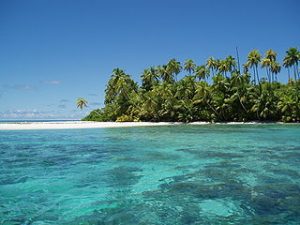Five Keys to Effective Marine Protected Areas
By Lindsay Jennings, RJD Intern
Marine Protected Areas, or MPAs, are areas of the ocean which have a degree of restricted human use for the purpose of protecting its natural resources as well as its ecosystem. Over the past years, the number of MPAs has grown rapidly as conservation efforts push the need for these critical refuges for vulnerable species. But the threat of overfishing still prevails in both coastal areas and in the open ocean, where these MPAs exist.

Salomon Atoll located in the Chagos Archipelago, the world’s largest marine reserve. Photo courtesy of Wikimedia Commons
Unfortunately, too often, MPAs fall short of reaching their full potential due to a host of problems including illegal harvesting, poor management, and the presence of animals which can move freely across the boundaries to be fished outside of the MPA. But Graham Edgar, from the University of Tasmania, along with 24 other researchers took on the first global study of its kind to identify what key factors produce effective MPAs and allow them to reach their full potential.
The researchers, along with trained volunteer divers surveyed 964 sites across 87 established MPAs identifying the key indicators of healthy MPAs such as species richness (i.e. how many unique fish species are found) and biomass (i.e. the total number of fish in a survey site). They compared these sites with non-MPA sites that are open to fishing. The results highlight the magnitude of how fishing can affect these species and ecosystems.

Distribution of sites surveyed with colored circles representing NOELI features. Photo courtesy of Edgar et al., 2014
Outside of MPAs (areas where fishing is allowed), Edgar et al. found total fish abundance drastically reduced, with upwards of an 80% reduction in large fish, including sharks, groupers, and jacks as compared to fish abundance within the MPAs. Inside these protected MPAs, the number of unique fish species found was 36% greater than that outside the MPAs in fished waters.
The outcome of the MPAs investigated resulted in the researchers concluding that conservation benefits increased greatly with five key features, which they named NOELI features.
- No take (no fishing or harvesting allowed)
- Well-enforced
- Old (>10 years)
- Large (> 100 km)
- Isolated
While not every MPA will meet all five criteria, it is crucial that future MPAs implement better design and management and compliance to ensure that these refuges achieve their full ecological potential and conservation value.
MPAs are remarkable conservation tools, if developed and managed properly. The researchers in this study stress that by removing the threat of fishing coupled with sufficient will among stakeholders, managers, and politicians, there can be increased levels of compliance, ultimately allowing the MPAs to reach their full conservation potential and fulfill their role of safeguarding populations of vulnerable species.




Leave a Reply
Want to join the discussion?Feel free to contribute!